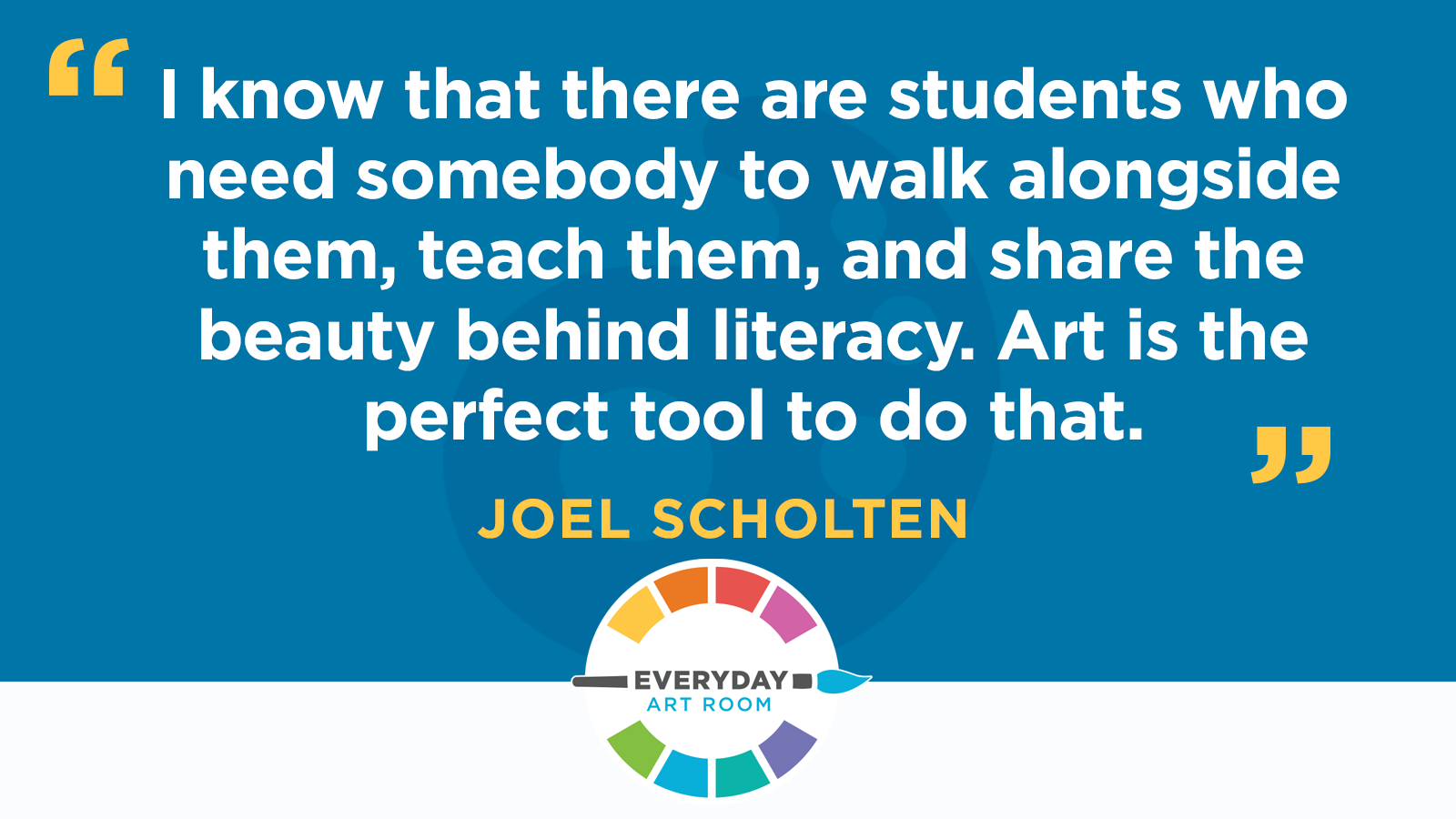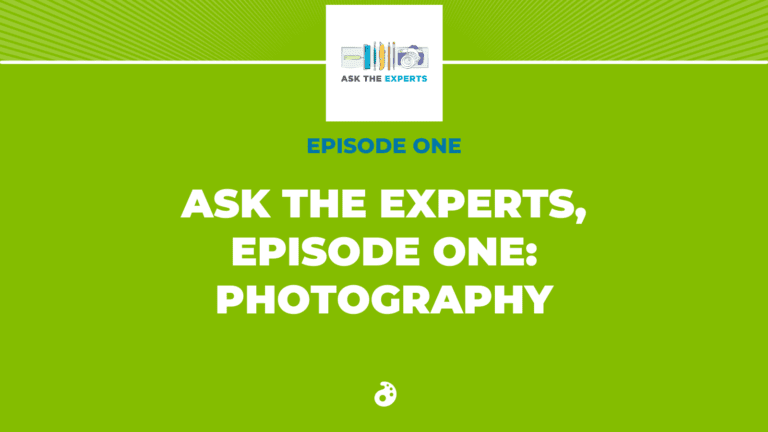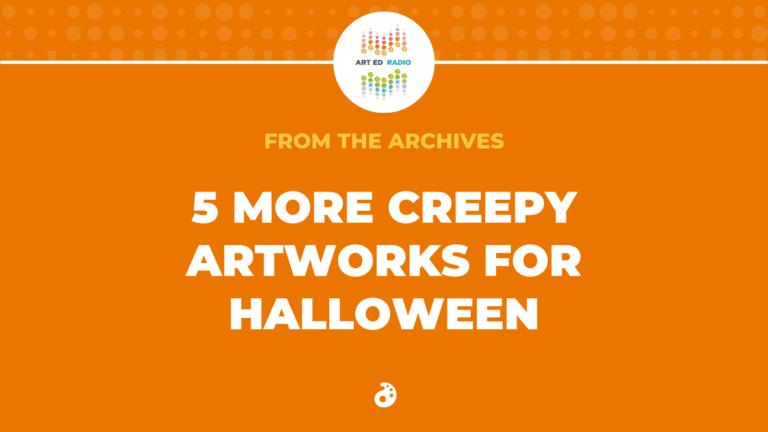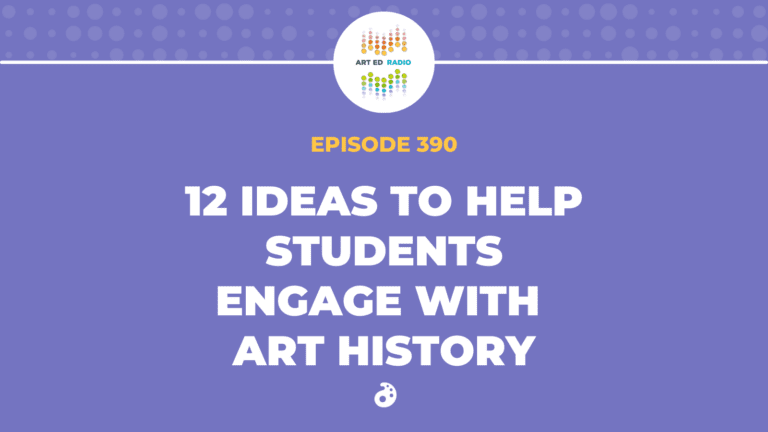Today, Joel Scholten is on the podcast to talk to Nic about how he uses art to help kids learn to love reading. Listen as they discuss Joel’s journey to teaching literacy, the beauty of storytelling, and how he tries to connect with literature at a higher level. Full Episode Transcript Below.
Resources and Links
- View all of AOEU’s resources to help with distance learning
- Follow Joel on Instagram
- Joel’s ‘Creative Curriculum’ blog

Transcript
Nic: Today, we’re going to talk to Joel Scholten, who is an art teacher in Nebraska. I initially inquired if he’d like to be a guest on Everyday Art Room because of his endorsement with reading and art education, but it turns out he has a lot more to share with us. So he’s going to talk about his roles with the Art of Education University. He’s going to talk about his path and how he ended up with this reading endorsement as well as art education, and then he’s going to talk about how he uses social media and how it has changed over time. He’s also going to talk about balance a little bit with his family and his work life. So let’s get started. This is Everyday Art Room, and this is your host Nic Hahn .
Joel, I am so excited to have you on the podcast today. First, why don’t you just give us a little bit of an introduction on you and your educational background and just let us know who you are.
Joel: Absolutely. I’ve been teaching art for approximately 13 years, and I’ve taught everything from kindergarten up through high school, I’ve taught in public and private schools, and currently I’m teaching K-5 art in the Omaha area. My first gig was actually at an art school, which was kind of fun. In Seattle, they don’t have a lot of funding for art, and so this school was kind of brought on as a nonprofit to run alongside of a school district, and so I was hired on right before the school year started. It’s a cool program, they offer afterschool programs for kids in the schools themselves. Then we also offered supplemental high school and AP courses for the high school as well.
The year that I started, the whole school district was going under accreditation, and they came back to us and said, “Hey, any content that’s being written needs to be written by a licensed teacher.” At that time, I was the only licensed teacher in the state of Washington. I was like two weeks into teaching, I had never taught by myself before. And so my And administrator said, “Here’s the deal, we need you to write all this curriculum for K-12. We’ll have the other teachers helping you, but you need to make sure that the lesson plans that you’re writing or the kinds of lesson plans that you were taught how to write.”
At the time, some of the other teachers weren’t very happy that I was overseeing their content, and so I didn’t really get very much help at all, and so the experience was just super overwhelming, but I think in those two years of teaching at that school, I learned a love of curriculum development, and you have to learn to embrace failure in the midst of all your critics, and you have to become a good problem solver, and you have to be flexible. I just realized that like almost every awesome project I’ve ever created kind of stem from something that was previously a total hot mess, and you just kind of roll with it.
I think even in front of your students, you have to be willing to acknowledge that, “You know what, this seemed like a really good idea. Let’s go back to the drawing board. Go back to your tables, probably do some problem solving on your own. Here’s some access to materials. Let’s see if we can figure out a solution to this problem.” I think kids love that kind of organic feeling too when they see that art as a whole as just this big problem solving think tank, and they can see that your failures can be turned into successes, not only as a teacher, but as an artist and a student in the art world.
Nic: I love it. I love it. Well, I know that… Actually, I recently found out that you are working with the Art of Education as well on top of being a K-5 art teacher in Nebraska. Can you tell us what kind of roles have you played with Art of Education as well?
Joel: Yeah. This spring, I released two pro packs. The first one is Art and Literacy. I also have my reading specialists endorsement, and so I led a pro pack on reading and literacy in the art room. Then I also let a pro pack on collage in the early elementary classroom. That was so much fun, I just loved the experience and just the positivity with everybody that I worked with at the Art of Ed, and I wound up applying for a position with the FLEX Curriculum, they just unrolled or rolled out a new FLEX curriculum, and I worked to align that curriculum to different states standards so that it’s easy for teachers in a specific state to kind of go in and find a lesson plan that aligns with maybe a standard that they’re trying to hit in their classroom. I’m just really excited about the curriculum that they’re creating, I just think it’s really well thought out, there’s tons of amazing resources that they provided and videos and handouts, and so I’m actually excited myself to use some of those things in my classroom.
Then also this summer, I am presenting the Art Ed Now Conference, and I’m going to be talking about how to use gel mediums in the elementary classroom.
Nic: Oh, I’m excited for that. I’ll be part of that as well. That sounds like a really good session. I can’t wait to see that. You mentioned the reading… One of your pro packs is increasing the literacy in the classroom and the art classroom, and that’s actually what kind of cued me into wanting to interview you. I saw on your Instagram, which I have followed and adored, you do a great job there, that you’re both an art teacher and a reading specialist. All right. This to me sounds like a lot, but now hearing your background, it kind of makes sense a little bit, but tell me how can those two roles… How do they relate to each other and how are you using them in your teaching right now, currently?
Joel: Yeah, absolutely. When I was looking to get my masters, I was looking for something that would diversify my license a little bit. At the time, I was maybe concerned about art cuts and the district that I was in, and so I wanted to diversify and make sure that I had another area that I could fall back on, even though artists like my biggest passion. I got to thinking about how much I love reading, reading is also one of my biggest passions. I am a voracious reader now, but when I was a kid, I hated reading, and I feel like my journey as a reader, and ultimately as a teacher, was deeply impacted by my fifth grade teacher who took me under his wing and just taught me a love of reading. I just remember, as a kid, just being in that moment when we were popcorn reading or reading around the room and I would like count the number of paragraphs and tell where I was and I would read it over and over and over again so that when I had to read, I wouldn’t feel or look stupid.
I remember thinking to myself, the only thing I remember from reading what the class is the paragraph that I read. As I began to think about my role as an educator, I thought about all the kids who are still currently in the education system who were just like me, who are counting down the paragraphs and terrified of reading. I just had such a low confidence in reading because I was so bad at it, but I was bad at it because I refused to read because I had no confidence, and it just became this like awful cyclical pattern where I couldn’t read because I didn’t want to read, and I didn’t want to read because I couldn’t.
My fifth-grade teacher just did a really great job of coming alongside of me and working with me and finding strategies that worked, not only that, but also finding texts that were deeply interesting to me. I remember he introduced me to the book Hatchet by Gary Paulsen, and I feel like my whole mindset in reading changed because I could not put that book down. Even though it took me twice as long as the rest of the class to finish, I had to reach the end of this book. I’m finding books that I love became part of this healing process between me and literacy. Like I said, I was kind of looking around at my students and noticing there are students who are like me that are needing somebody to walk alongside them, teach them and needing an opportunity to be shared the beauty behind literacy.
That was kind of my original reasoning behind it, but then as I started working through my master’s program, I really started making these connections between art and literacy. They are really so easy to interweave, and it’s because the job of an artist is very similar to the job of an author. Art tells a story. Great art is telling you something, it’s teaching you something, it’s entertaining you, it’s persuading you, and those are the kinds of things that authors do in books. When I realized that artists and writers had similar motivations in creating their content, it became easier for me to connect literature to my art lessons, and instead of it just being a book where I would pick out a book about penguins, because we were making penguin sculptures, it became a process of searching for a way to find connections between literature and art at a higher level, and then pushing the kids to make those connections.
In a similar way, I realized that I could use my platform as an art teacher. We are kind of like the magical mystical creatures in the art room. I mentioned this in my pro pack as well when I talked about literacy, kids look up to us, and I think we just bring a whimsy and a magic to the classroom, especially for those students who are struggling in the core curricular areas, they are finding success and acceptance and love in our classroom, and so we have this really kind of beautiful platform to teach them to learn the love of reading too.
It’s really simple concepts. Like I said, bringing concepts back and having them consider concepts, this isn’t just a story about a penguin, but it’s a story that connects ideas. For example, a couple of years ago, I started teaching this lesson about an artist named Kyle Meyer, he’s a contemporary artist, and he weaves images of men who are in hiding because of their sexual orientation, and so they’re fleeing genocide and they’re hiding. And so he weaves these beautiful portraits of these men with cloth that they use to cover their heads. In that way, he’s using his platform as an artist to speak up for people who don’t have their own voice.
To tie that into literacy, I pulled in a book called One. It’s about these colors, the color blue is always getting picked on by the color red, and the other colors are friends with blue, but they’re so afraid to speak up for him. Along comes the number one, and yet he stands up for blue and he says, “Everybody should count.” And because one was brave and he spoke up against the way red was treating blue, the other color said, “You know what, we want to count too,” and they stood up for blue as well. And it’s that concept of the power of one person’s word and how they can really change the mindset of a whole group of people.
And so just connecting those ideas, and I don’t lay it out for the kids, the kids have to kind of connect it themselves, and lots of times I have them write just a simple journal reflection, how is the artist Kyle Meyer kind of like the number one in this book? What is the author of this book trying to teach us? What is Kyle Meyer trying to teach us? Can you make those connections on your own? Kids are learning to find deeper connections, they’re learning to love books. Something as simple as having silly character voices when you read, or getting excited about the illustrations, taking them on a picture walk, those simple concepts can really just promote buy-in in any book that you’re reading, and then that translates to, “Oh my goodness, I love that book.”
Nic: Right. And I think it’s the way that you’re presenting it too, and it’s a little bit of a mind shift for me. I have typically done a cute little picture of a sun, and then we find a sun book or vice versa, or I’m inspired by books on a regular basis, but you’re going much deeper saying, “Here’s the concept of what the illustrator/artist or author is doing, and look at… It’s the same as what an artist does.” That is a great realization for your students. That’s a powerful way to present that.
Joel: Yeah. Yeah.
Nic: Okay. We could probably talk for another three hours on that, but I want to give people a little bit more of an insight of you. When you look at your Instagram bio, it has all these tiny little words that hold such big meaning. Your Instagram tag says, “I’m an art teacher, a reading specialist,” which we’ve talked about, “but I’m also an artist devoted husband and enthusiastic father.” Really, those are tiny little words that have such big meaning in this life. How do you find time for all of those roles, and where are you finding balance in that?
Joel: Nic, I’ll be honest, balance is really difficult. Being a parent is a really tough, full-time job, you know?
Nic: Yeah, I do.
Joel: And being a teacher is a really tough, full-time job. And I’m the kind of person that when I fall into something, I want to be really good at it, and so, “I want to be a really good teacher. I want to be a really good dad. I want to be a really good husband.” One of the ways, I think, that I have found a balance is understanding where the roles overlap in between those jobs or those titles. For example, I love reading and my kids love reading too, and so in the summers, we’ve built this beautiful book nook in one of our rooms and it’s like a fort that we created out of PVC piping. And I got a little weaving station in there for my kids where they can weave. We have a post-it art gallery where the kids reflect on what they’ve learned and they draw a picture of something that they’ve read or that they remember from a story, and we read together quite a bit, especially in the summers, we’re going through the Harry Potter series together, which has been just a ton of fun.
Also, when I’m looking to develop new ideas for curriculum, the summer’s a great time for that. I have two school-aged kids, so I’m constantly thinking, “Okay, is this a project that I would do with a primary student or with an intermediate student?” And I do this project with my kids and I’m looking at the semantics of presenting this lesson, “Can I do this with one 10-year-old? Because if I can’t do it with one 10 year old, there’s no way to be able to do this project with 20 10-year-olds in one classroom.”
And so my kids get to see a lot of bare-bones ideas in terms of my lesson planning. I remember one year I wanted to do these really cool yarn woven rainbow things and they were just constantly running out of yarn, and I tried to teach them how to thread their own needles and they couldn’t do it. I thought, “This is going to be utter chaos in a fourth-grade classroom.” And so I shelved that idea, and it’s good for my kids to be able to see my failure as well as a teacher, and it’s good for them to see me go back to the drawing board and me to have to problem solve and me to roll with the punches and have kind of tenacity and revisit ideas and themes. It’s good for them to see that because it instills some of those virtues in them as well.
Nic: Sure.
Joel: Likewise, when I’m creating, my kids want to come alongside of me and create. I remember my wife got this beautiful picture of me when my daughter was just two, I was painting a mural, and I was sitting in a chair and she was sitting in my lap just watching me paint, and my wife came along and took this amazing photo. The kids, they want to be a part of that creative process, I think it’s really innate in children. I paint with encaustics, which can be kind of dangerous. I let my 10-year-olds dabble with encaustics a little bit. But because it’s working with melted wax, I obviously don’t want my six-year-old. But even him, he’ll saddle up next to me with his watercolors at the counter, and he’ll be creating with me and showing me what he can do and I’ll show him what I’ve done. It’s this beautiful collaborative project, even though we’re working on two different things. I love really bright colors and he loves really bright colors, and what happens when we mix these colors? What does it look like in watercolor? What does it look like in encaustic?
And so I’m bringing them in the creative process, even though really what I’m doing is kind of more on a professional level, they can still be along with me in that process.
Nic: Yeah. Yeah. I love that. It’s beautiful, because if it’s enriching the students of your classroom, why wouldn’t you have it enrich your personal children as well? It’s a clever way to do it. Of course, you mentioned you’re going so much deeper than just, “Let’s do this project together.” You’re teaching them about the whole creative process, and the mistakes and all. That’s beautiful. Now, I know you mostly virtually, we’ve been getting to know each other a little bit more in the last couple of weeks as we’ve been communicating, but I’ve followed your Instagram for a while, and I’m just wondering, and I think other people who might be considering or have some platform that they’re sharing, tell us about how you share and how this has evolved over time, why do you do what you do, why do you share what you share, and how has it changed over time?
Joel: Yeah. Well, for me, I absolutely love the collaborative process in teaching. I just feel like there’s this beautiful energy that develops between two or three or four people as your… Like coming upon the path of a beautiful idea. And so you might have something really noteworthy, but when somebody else brings along their perspective, it only enriches the process of curriculum development or lesson development.
Several years ago, I was working on an art cart and I was actually teaching from the same cart as another fabulous teacher. Her name is Abby Schukei. I remember we had this little tiny closet and we would walk in, we barely had any room for our supplies or carts, but I remember looking at her work and thinking, “Oh my gosh, this is such a great idea. This is such a great lesson. What a fun project. I want to do it myself.” Then I would kind of sit on that project and think, “Okay, but what if I did it in this material?” Or, “What if I brought in this concept or this artist or this book?” Then I would share that with her and she would do the same thing.
I feel like there became a point where it was really hard to tell almost whose lesson plan it was, because we were kind of constantly feeding off each other, and I think it elevated both of us as teachers. This has become my absolute favorite part of teaching, cultivating and embellishing on ideas.
There’s, like I said, a beautiful energy that develops between people when you’ve embarked on this beautiful idea, and so I have enjoyed collaborating also with classroom teachers. They’re teaching things that we can obviously readdress in our room. Like I said earlier with literacy, like we have just this beautiful platform where kids feel safe in our classroom and kids are able to explore and express themselves in ways that aren’t always available in the classroom, and so if I can help a student along learning about, for example, the parts of an insect or the parts of a flower by doing a project that incorporates not only my learning goals, but their learning goals as well, why wouldn’t I do that? That’s not only helping my colleagues, it’s helping my students, and it’s really building this connection between art and other parts of our lives.
About six years ago, I had a friend who was… I was teaching where she moved to a really small school district and she was thrown into this not knowing she was going to have to teach art to her classroom. But to complicate the whole situation, it was required by the district that her art projects had to very explicitly meet the learning targets of core subjects like math or science or reading. She didn’t know where to begin, so she reached out to me and said, “Hey, here’s the deal. I have to present art once a month, but it has to connect in these areas. Are there any ways that you can help me?”
I began to brainstorm and kind of cultivate these ideas and I thought, “You know what, these are really great lesson plans.” And so I created a blog and I started to share my lesson plans with her on my blog, but I thought, “You know what, if we’re putting in all this work, creating these lesson plans, there has to be other teachers out in the world who are looking for similar concepts or ideas or lessons. We already work hard enough. Why aren’t we sharing?” I love the idea that teachers are all in this together.
And so I began sharing my lesson plans on my blog, hoping that some other teacher could save a couple of hours of non-contract time just by using the resources and things that I’ve already developed. Abby, the teacher I was working with at the time, said, “You should really get on Twitter, because I think there’d be a better platform there for you, and I think you’d have more access to ideas on Twitter as well.” I begrudgingly walked into Twitter and wasn’t sure how it would work, but I immediately found this beautiful art teacher community, and I think that’s originally where I started following you. I just found like a treasure trove of ideas, and people really seemed to be receptive to my lesson plans as well, and I just fell in love with this idea of sharing ideas on Twitter.
It wasn’t long after that, that Abby was like, “Okay, but you should really be on Instagram, because there’s a really good community.”
Nic: She’s good like that. Yeah.
Joel: I thought, “You know what, I can’t do Instagram. I’m too old. I’m not pretty enough.” I just kept telling myself these things, like, “I’ve got two kids. I don’t have time to constantly be spewing out content.” It seemed really overwhelming to me at first, and so I really hesitated to join the community, but Abby wore me down, and I finally got into the Instagram community. Once again, it was just like this beautiful community. I feel like people were really embracing the authentic nature of my posting. I didn’t feel like I had to post all the time, I didn’t feel like I had to rise to a level of content to be able to post. I was just posting the lessons I was doing and I was posting the thoughts that I had, or the things I was doing with my kids, and I was getting a really great response to that. In the same way, I was really inspired by the other art teachers who were on the platform.
You know what, you don’t have to be beautiful or young to be able to have great ideas. And so Instagram has just become a really great platform, I think, for people all over the country and the world to be able to interact. I remember a couple of years ago, I had posted a lesson plan that I had done about an artist. He paints on people and he uses different patterns to tell a story. It’s really beautiful how his process works because he talks to the person he’s working on and learns about them and gets to know them in a way that he can share their story through pattern on their body, which is a beautiful process.
I had photograph of my students and we looked at his work, and because he’s a contemporary artist, I was able to find all kinds of great material on him, videos and photographs and all kinds of great stuff that we could use, and the students created a story about themselves using pattern. What’s awesome is it hit a couple of different of my learning targets for second grade, pattern making and storytelling. I was just blown away and so inspired by not only their photographs, but also their journal responses that I felt like I had to post this on my blog, as well on my Instagram feed. [inaudible 00:31:13] saw it and reposted it and just showered my students in praise. It was beautiful because he was responding to questions that they had and basically dialoguing with them over Instagram, and I thought, “This is my place.” Not only using it to gain new ideas, but I’m using it to help students interact with the world and meet artists.
Jason Naylor is the same way. I had used him. I compared his street art to Banksy’s street art and the kids created an example of street art on large format paper. Jason Naylor was just so great and interactive and gave our students such positive praise and pushed them along. It was such a neat way to provide buy-in for the kids too, they were excited to see that real professional artists were praising their work and seeing value in their work. That’s incredible. I mean, you can’t find that other places.
Nic: No. I love hearing the path that that has taken and how it’s turned them into some different forms for you and things that you didn’t even expect or anticipate or were seeking when you started sharing. So you created this little closet that you shared with Abby and you created it on such a bigger platform for yourself and you’re getting new ideas all the time, I’m sure, and you’re definitely sharing, in fact, those lessons. I have been inspired by you and have brought into my own classrooms.
Joel: Thank you.
Nic: I just am so grateful for you taking the time to meet with us today and talk a little bit about your experiences in especially the literacy, but then also how you’re sharing and giving back to the world here and making it all work into your very busy life. Joel, thank you for visiting with us today.
Joel: Thank you so much, Nic. It was great chatting with you.
Nic: That was an awesome conversation. Thank you, Joel, for sharing your heart with us. My goodness. I learned a lot. If you didn’t get enough in this, you heard him mention he has a pro pack. He is involved, he has his fingers in FLEX. So he’s with the Art of Education University in many capacities as well. And you also heard that he’s going to be presenting at the upcoming summer Art Ed Now Conference. I, for one, can’t wait to hear what he has to say. I will talk to you again next Thursday on Everyday Art Room.
Magazine articles and podcasts are opinions of professional education contributors and do not necessarily represent the position of the Art of Education University (AOEU) or its academic offerings. Contributors use terms in the way they are most often talked about in the scope of their educational experiences.



